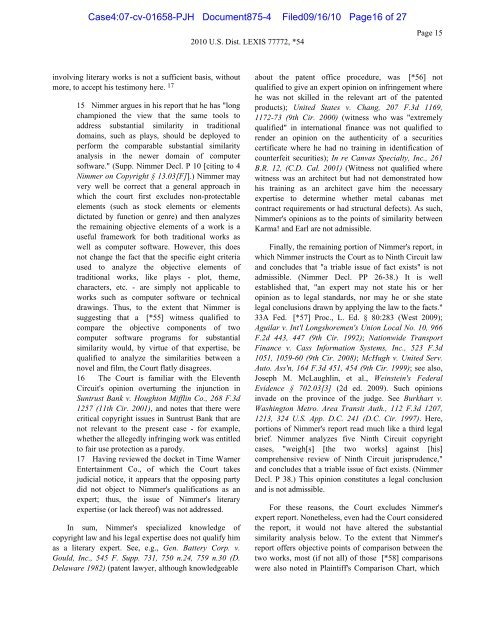exhibit 2 - SAP Lawsuit Portal
exhibit 2 - SAP Lawsuit Portal
exhibit 2 - SAP Lawsuit Portal
You also want an ePaper? Increase the reach of your titles
YUMPU automatically turns print PDFs into web optimized ePapers that Google loves.
Case4:07-cv-01658-PJH Document875-4 Filed09/16/10 Page16 of 27<br />
involving literary works is not a sufficient basis, without<br />
more, to accept his testimony here. 17<br />
15 Nimmer argues in his report that he has "long<br />
championed the view that the same tools to<br />
address substantial similarity in traditional<br />
domains, such as plays, should be deployed to<br />
perform the comparable substantial similarity<br />
analysis in the newer domain of computer<br />
software." (Supp. Nimmer Decl. P 10 [citing to 4<br />
Nimmer on Copyright § 13.03[F]].) Nimmer may<br />
very well be correct that a general approach in<br />
which the court first excludes non-protectable<br />
elements (such as stock elements or elements<br />
dictated by function or genre) and then analyzes<br />
the remaining objective elements of a work is a<br />
useful framework for both traditional works as<br />
well as computer software. However, this does<br />
not change the fact that the specific eight criteria<br />
used to analyze the objective elements of<br />
traditional works, like plays - plot, theme,<br />
characters, etc. - are simply not applicable to<br />
works such as computer software or technical<br />
drawings. Thus, to the extent that Nimmer is<br />
suggesting that a [*55] witness qualified to<br />
compare the objective components of two<br />
computer software programs for substantial<br />
similarity would, by virtue of that expertise, be<br />
qualified to analyze the similarities between a<br />
novel and film, the Court flatly disagrees.<br />
16 The Court is familiar with the Eleventh<br />
Circuit's opinion overturning the injunction in<br />
Suntrust Bank v. Houghton Mifflin Co., 268 F.3d<br />
1257 (11th Cir. 2001), and notes that there were<br />
critical copyright issues in Suntrust Bank that are<br />
not relevant to the present case - for example,<br />
whether the allegedly infringing work was entitled<br />
to fair use protection as a parody.<br />
17 Having reviewed the docket in Time Warner<br />
Entertainment Co., of which the Court takes<br />
judicial notice, it appears that the opposing party<br />
did not object to Nimmer's qualifications as an<br />
expert; thus, the issue of Nimmer's literary<br />
expertise (or lack thereof) was not addressed.<br />
In sum, Nimmer's specialized knowledge of<br />
copyright law and his legal expertise does not qualify him<br />
as a literary expert. See, e.g., Gen. Battery Corp. v.<br />
Gould, Inc., 545 F. Supp. 731, 750 n.24, 759 n.30 (D.<br />
Delaware 1982) (patent lawyer, although knowledgeable<br />
2010 U.S. Dist. LEXIS 77772, *54<br />
Page 15<br />
about the patent office procedure, was [*56] not<br />
qualified to give an expert opinion on infringement where<br />
he was not skilled in the relevant art of the patented<br />
products); United States v. Chang, 207 F.3d 1169,<br />
1172-73 (9th Cir. 2000) (witness who was "extremely<br />
qualified" in international finance was not qualified to<br />
render an opinion on the authenticity of a securities<br />
certificate where he had no training in identification of<br />
counterfeit securities); In re Canvas Specialty, Inc., 261<br />
B.R. 12, (C.D. Cal. 2001) (Witness not qualified where<br />
witness was an architect but had not demonstrated how<br />
his training as an architect gave him the necessary<br />
expertise to determine whether metal cabanas met<br />
contract requirements or had structural defects). As such,<br />
Nimmer's opinions as to the points of similarity between<br />
Karma! and Earl are not admissible.<br />
Finally, the remaining portion of Nimmer's report, in<br />
which Nimmer instructs the Court as to Ninth Circuit law<br />
and concludes that "a triable issue of fact exists" is not<br />
admissible. (Nimmer Decl. PP 26-38.) It is well<br />
established that, "an expert may not state his or her<br />
opinion as to legal standards, nor may he or she state<br />
legal conclusions drawn by applying the law to the facts."<br />
33A Fed. [*57] Proc., L. Ed. § 80:283 (West 2009);<br />
Aguilar v. Int'l Longshoremen's Union Local No. 10, 966<br />
F.2d 443, 447 (9th Cir. 1992); Nationwide Transport<br />
Finance v. Cass Information Systems, Inc., 523 F.3d<br />
1051, 1059-60 (9th Cir. 2008); McHugh v. United Serv.<br />
Auto. Ass'n, 164 F.3d 451, 454 (9th Cir. 1999); see also,<br />
Joseph M. McLaughlin, et al., Weinstein's Federal<br />
Evidence § 702.03[3] (2d ed. 2009). Such opinions<br />
invade on the province of the judge. See Burkhart v.<br />
Washington Metro. Area Transit Auth., 112 F.3d 1207,<br />
1213, 324 U.S. App. D.C. 241 (D.C. Cir. 1997). Here,<br />
portions of Nimmer's report read much like a third legal<br />
brief. Nimmer analyzes five Ninth Circuit copyright<br />
cases, "weigh[s] [the two works] against [his]<br />
comprehensive review of Ninth Circuit jurisprudence,"<br />
and concludes that a triable issue of fact exists. (Nimmer<br />
Decl. P 38.) This opinion constitutes a legal conclusion<br />
and is not admissible.<br />
For these reasons, the Court excludes Nimmer's<br />
expert report. Nonetheless, even had the Court considered<br />
the report, it would not have altered the substantial<br />
similarity analysis below. To the extent that Nimmer's<br />
report offers objective points of comparison between the<br />
two works, most (if not all) of those [*58] comparisons<br />
were also noted in Plaintiff's Comparison Chart, which


